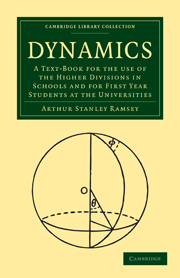 Dynamics
Dynamics Book contents
- Frontmatter
- PREFACE
- Contents
- Chapter I INTRODUCTION
- Chapter II VECTORS
- Chapter III RECTILINEAR MOTION. KINEMATICS
- Chapter IV RECTILINEAR MOTION. KINETICS
- Chapter V KINEMATICS IN TWO DIMENSIONS
- Chapter VI DYNAMICAL PROBLEMS IN TWO DIMENSIONS
- Chapter VII HARMONIC MOTION
- Chapter VIII MOTION UNDER CONSTRAINT
- Chapter IX THE LAW OF REACTION. GENERAL PRINCIPLES
- Chapter X GENERAL PROBLEMS
- Chapter XI IMPULSIVE MOTION
- Chapter XII POLAR COORDINATES. ORBITS
- Chapter XIII MOMENTS OF INERTIA
- Chapter XIV MOTION OF A RIGID BODY. ENERGY AND MOMENTUM
- Chapter XV EQUATIONS OF MOTION OF A RIGID BODY
- Chapter XVI MISCELLANEOUS PROBLEMS
- Chapter XVII SMALL OSCILLATIONS
Chapter IX - THE LAW OF REACTION. GENERAL PRINCIPLES
Published online by Cambridge University Press: 07 September 2010
- Frontmatter
- PREFACE
- Contents
- Chapter I INTRODUCTION
- Chapter II VECTORS
- Chapter III RECTILINEAR MOTION. KINEMATICS
- Chapter IV RECTILINEAR MOTION. KINETICS
- Chapter V KINEMATICS IN TWO DIMENSIONS
- Chapter VI DYNAMICAL PROBLEMS IN TWO DIMENSIONS
- Chapter VII HARMONIC MOTION
- Chapter VIII MOTION UNDER CONSTRAINT
- Chapter IX THE LAW OF REACTION. GENERAL PRINCIPLES
- Chapter X GENERAL PROBLEMS
- Chapter XI IMPULSIVE MOTION
- Chapter XII POLAR COORDINATES. ORBITS
- Chapter XIII MOMENTS OF INERTIA
- Chapter XIV MOTION OF A RIGID BODY. ENERGY AND MOMENTUM
- Chapter XV EQUATIONS OF MOTION OF A RIGID BODY
- Chapter XVI MISCELLANEOUS PROBLEMS
- Chapter XVII SMALL OSCILLATIONS
Summary
9·1. So far we have been concerned with the motion of a single particle. When two or more particles are moving in such a manner that the motion of any one is affected by the presence of the others we have to make use of another law enunciated by Newton, viz. Action and Reaction are equal and opposite, or, the actions of two bodies on one another are always equal and opposite. In explicit terms this means that if a body A exerts a force F on a body B, then B exerts an equal force F on A but in the opposite direction. Consequently the momentum communicated to A by the action of B is equal and opposite to the momentum communicated to B by the action of A.
Consider the case of a system of bodies, attracting or repelling each other or acting on one another by contact, or through connections by means of strings or rods, either for a finite time or by instantaneous impulses. In this case any momentum which is produced or destroyed in any assigned direction is accompanied by the production or destruction of an equal momentum in the opposite direction.
Hence it follows that, if no external forces act on a system of bodies, the total momentum, of the system, in any assigned direction remains constant.
- Type
- Chapter
- Information
- DynamicsA Text-Book for the Use of the Higher Divisions in Schools and for First Year Students at the Universities, pp. 114 - 122Publisher: Cambridge University PressPrint publication year: 2009First published in: 1929
